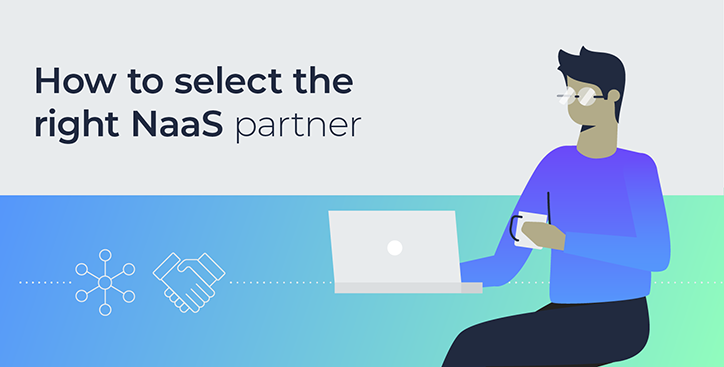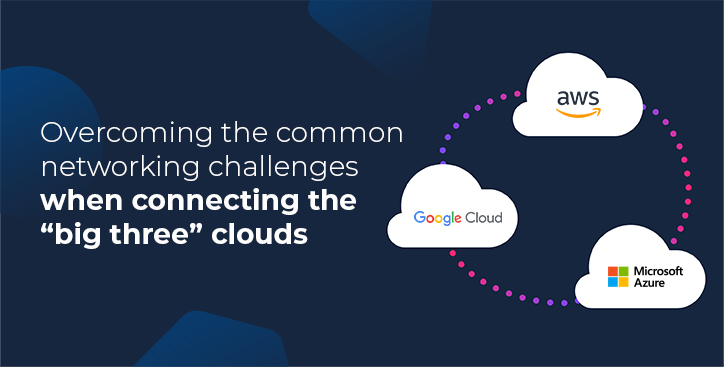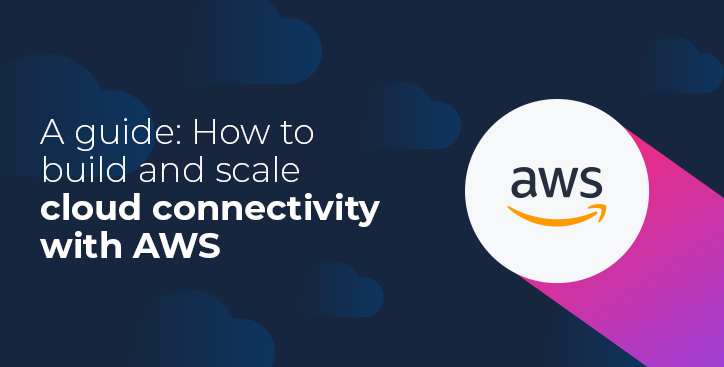How to select the right NaaS partner
By Alex Hawkes|17 January, 2022

The end-goal for a CIO adopting a Network-as-a-Service (NaaS) approach is to create a predictable, cloud-like consumption model for enterprise infrastructure.
NaaS is designed to ensure that the enterprise network is state of the art and continually adopts innovations, frees the enterprise IT staff from monitoring tasks, rolls up the range of SLAs, and reduces the need for specialist skills in-house.
But it’s a transformation that can’t be fully realised without the support of the underlying network - and that means finding the right NaaS partner.
The right NaaS partner can make the digital transformation journey as smooth as possible, so we’ve put together a handy checklist of items you should be considering when choosing your provider.
How extensive is the underlying network reach?
One of the core benefits of NaaS relies on the pre-provisioning of connectivity to relevant sites, locations, and geographies. The traditional model of network procurement was very reactive - once the request is made the provider would send an engineer to the data centre to run new cabling, or would create a work order to run fibre to a building, a process that could take weeks or months.
But as NaaS providers have scaled up their own offerings, they have already done all the hardware pre-provisioning, allowing the customer to make the required network changes in software, in near real-time.
This gives the enterprise much more agility at a time when digital transformation raises the challenge of a growing network footprint for many businesses, which must now support more users, devices, and locations than ever before.
So the key question is whether your NaaS provider’s network footprint matches up with your own in terms of relevant data centres, corporate sites, clouds and internet exchanges - and whether they have reach beyond their own network footprint through partnerships.
Which of your existing cloud and SaaS partners are integrated with the NaaS platform?
With so many organisations relying on public cloud and SaaS, it’s essential to ensure that your NaaS provider is connected to the services your business uses.
The Flexera 2021 State of the Cloud Report, found that an estimated 92% of companies are adopting a multi-cloud approach, with respondents to its study currently using an average of 2.6 public and 2.7 private clouds within their infrastructure, suggesting multi- and hybrid- setups have become commonplace.
This is more frequently by accident rather than design – for example, an organisation may have selected AWS as its IaaS (Infrastructure-as-a-Service) of choice but then realised it has an Office 365 instance running on Microsoft Azure and has some people doing work in that environment.
Chances are your business already uses a variety of SaaS tools company-wide and as an engineer or CIO you will be expected to plan the corporate network to support the likes of Office 365, Zoom, or Slack.
But the ease of adoption of SaaS means parts of the business may have integrated tools of their own accord, and some of those tools may even now be mission critical. For example, sales and marketing may have come to rely on Hubspot, or perhaps customer support depends on Drift or Zendesk.
This is driving further demand for enterprises to get direct connectivity to SaaS instances to deliver better performance, which is especially noticeable when it comes to real-time communication or other low-latency dependent applications
Being able to plug into a SaaS app directly from their own data centre gives enterprises the levels of security and reliability that has historically been used for mission critical infrastructure, which avoids sending traffic over the public internet.
It is therefore essential to do a thorough audit of the cloud and SaaS providers your business currently depends on – and those which maybe on your future roadmap – to check they align with your NaaS provider’s ecosystem.
Does the partner provide access to the right APIs?
Just as it’s important to ensure your provider connects to the relevant clouds and services, you also need to ensure they support the most relevant Application Programming Interfaces (APIs).
Generally speaking, APIs exist to ensure that connectivity between different assets remains strong enough to enable efficient collaboration even as workflows and processes are changing. By some estimations at least 50% of all B2B collaboration occurs via APIs and this number is surely going up.
Without access to APIs, an organisation can’t easily interact with its partners’ data, and collaboration and connectivity to infrastructure assets will be compromised.
Unfortunately, there's no incentive for cloud providers to provide a single co-defined open API for connectivity. As a result, cloud and SaaS providers all use wildly different workflows, creating a headache for engineers relying on an increasing number of these assets.
But the benefits of NaaS platforms like Console Connect is that they abstract all that from a customer perspective, creating API endpoints that look almost identical. Ultimately yes, enterprises still need to do some of their own internal development but Console Connect is doing most of the heavy lifting by creating an API ecosystem that is abstracting the rate of change that happens in these cloud provider API endpoints.
This translates into providing a consistent experience and a stable API endpoint for the enterprise, and going some distance to unify that experience. So, whether an organisation is doing a backup into Microsoft Azure or a backup into Alibaba Cloud you see basically the same API endpoints on Console Connect, even though there are different workflows happening behind the scenes.
How stringent are the networking SLAs?
NaaS delivers an opportunity for enterprises to roll up and aggregate their network Service Level Agreements (SLAs).
SLAs are created with network providers to guarantee levels of availability, uptime, and response for addressing network issues, and enterprises typically end up with an overlapping patchwork of SLAs from different providers that apply to different parts of their WAN.
With the ability to grow the network as your organisation grows, using a NaaS model, enterprises can consolidate the number of providers and thus the differentiation between, and number of, SLAs.
The private connections established via NaaS is one way to ensure consistently reliable and high-quality delivery of services and applications. Private links can be configured to prioritise certain classes of service, ensuring applications that are more latency-sensitive have their specific demands met.
In this respect, Console Connect offers a high-quality uncontended, low-latency network backed with a stringent SLA, which you should ensure matches your requirements.
How does the cost of the NaaS solution compare to a traditional network?
In short, NaaS, as with any ‘x-as-a-service’, is the continuation of a trend towards renting rather than owning infrastructure and applications, which for businesses also means a shift from capex to opex and an increase in agility as digital transformation rolls on.
It’s important not to view NaaS as a ‘cheaper’ option, but as a different model for consuming network infrastructure. As described by industry analyst IDC, “Businesses are exploring consumption-based models in the network as a means to speed up digital transformation, reduce risk and capital costs, and enhance scalability.”
Obviously there are some obvious gains - the network provider owns and maintains the network, managing software and hardware upgrades. Purchasing services instead of building your own can result in cost savings as enterprises do not need to purchase and maintain hardware.
But more importantly, capacity can be increased, decreased, and moved around the network as required, giving more granular cost control.
Think of it like a cloud approach to network consumption – you only pay for what you use, with connections available for hours, days, weeks, months or years.
Ultimately, the right NaaS partner can make the digital transformation journey as smooth as possible, minimising expenses related to the implementation of new processes and equipment, and ensuring organisational agility going forward.






.jpg)


